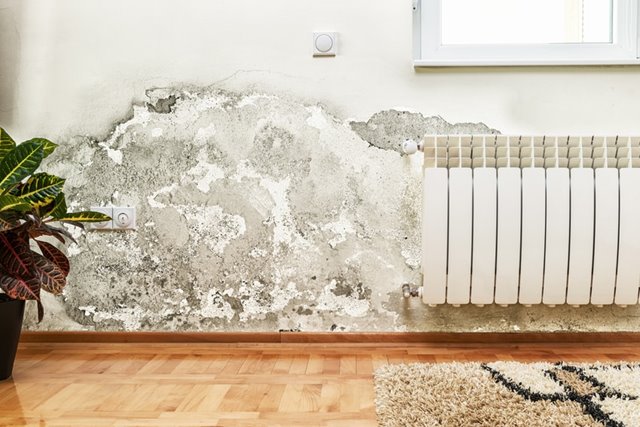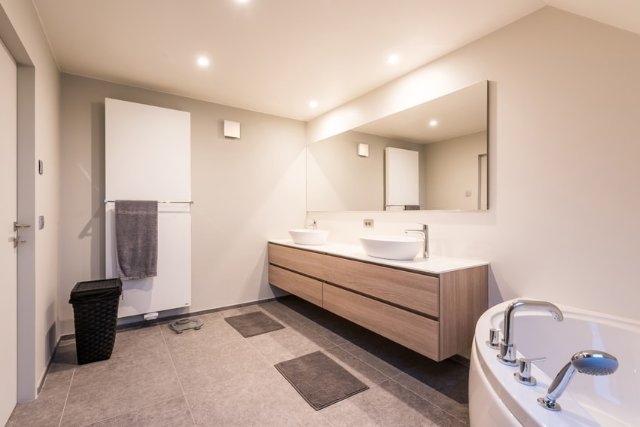Types of ventilation for your bathroom
Air that’s too humid is bad for your home. That said, in wet rooms like your bathroom, for example, humid air cannot be avoided. Excess moisture will deposit on colder surface areas like walls, windows, mirrors or ceilings, and damp patches, mould and odours may form as a result. These problems are not just detrimental to your home; they are detrimental to your own health too. Fortunately, there’s an easy solution: proper ventilation! Opening the window is an initial step in the right direction, but in most cases, doing so won’t be enough to remove all humid air from the room. And that’s where a good bathroom ventilation system can offer solace.
Hot water is a constant feature of a bathroom: when you’re in the shower or when you’re running a bath, you’re producing a lot of water vapour. When that water vapour isn’t adequately extracted from the room, condensation will form on colder surface areas in your bathroom: walls, windows, mirrors, the ceiling and so on. And while a steamed-up mirror may be annoying, things could be a lot worse: permanently damp walls and windows are the perfect breeding ground for mould. Damp issues around the home can cause a lot of damage. Too much humidity means you run the risk of:
mould in the house, which can cause permanent damage
dry rot, in extreme cases, which can cause damage to the wood in your bathroom interior
condensation on your mirrors or windows
damage to materials in your bathroom that retain moisture
It’s not just your home that will suffer the consequences; if the problem starts to spread, it can be harmful to your health in the long term too. As such, bathroom ventilation is essential. mould in the house

There’s always something new to be found on the market for bathroom ventilation, and the wide range of different technologies and systems available means you’re bound to find a solution that’s just right for you. What exactly that solution is depends on various factors, and we’ll gladly run you through the available options below.
Bathroom fans are a budget-friendly solution that take little effort to install. They are available for short or long extraction ducting, in surface-mounted or built-in versions, and in wall or ceiling versions.
There are three categories of bathroom fans:
Surface-mounted fans are cheap and easy to install. Bathroom fans with a humidity sensor or motion detector operate fully automatically.
Inline fans are a good alternative for small bathrooms. These fans are placed inside the extraction ducting.
Duct fans can easily extract air over longer distances, invisibly and near-silently.
Renson Waves is a solution that goes one step beyond the categories listed above. Just like an inline fan, Waves can be connected to existing air ducting, meaning no extra cutting or drilling work is required to install it. As a result, Waves is the ideal solution for renovation projects. That said, Waves actually goes one step beyond conventional bathroom fans. With sensors that monitor and analyse the air in your bathroom, Waves is much more of a ‘smart’ ventilation system, like Healthbox 3.0. As soon as the system notices that the humidity level is changing and a critical threshold value is exceeded, it will start ventilating fully automatically — and it will keep doing so until the right air quality balance has been restored.
Now that you’ve grasped the importance of proper ventilation in your bathroom and you’re ready to roll up your sleeves, it’s best to position your fan as close as possible to the source of the water vapour. Doing so will guarantee optimal effectiveness, but safety also needs to be considered. As a result, you can’t simply position your bathroom fan anywhere you like. Depending on the humidity level and safety considerations for electrical devices, bathrooms are divided into different zones:
zone 0: no electrical equipment whatsoever is permitted inside your bathtub or shower, including fans.
zone 1: the zone from the bottom of your bathtub or shower up to a height of 2.25 m is safe for IPX4-rated electrical equipment up to 12 V AC or 30 V DC. Only double-insulated electrical devices connected to a circuit breaker located outside of the bathroom are permitted in this zone.
zone 2: this zone extends 60 cm outside of zones 0 and 1, or about arm’s length away from the shower or bath. All IPX4-rated bathroom fans are safe to install here.
zone 3: everything outside of zone 2. All IPX1-rated devices are safe to install here.
To put it briefly, the best place to install a fan is in zone 2 or 3. A professional installer will be able to explain exactly where a fan can and cannot be positioned.

Whether you’d like to keep tabs on the exact air quality in your home or bathroom or whether you’re confident everything is just fine and you’re looking for a way to prove it, Renson Sense is a great solution to monitor the air quality in your bathroom. After all, to measure is to know!
Renson Sense
Sense is a smart CO2 monitor that displays information about your air quality using colour codes. Blue means everything is fine, amber means there’s room for improvement and red means your air quality has veered into unhealthy territory. In other words, red means it’s time to turn up your ventilation. The device also monitors humidity levels — making it ideal for use in bathrooms — and volatile organic compounds (VOCs): harmful substances originating from paint, varnish and so on that are emitted into the air. One other advantage of Sense is that it’s possible to view historic values. That way, you can check whether an issue is occurring on a regular basis. If it is, you’ll need a structural solution like Waves.
Renson Waves
Just like Sense, Waves monitors your air quality. Waves goes one step further though: it proactively intervenes whenever necessary. Even though the system operates fully automatically and takes action based on its own measurements, you can view the historical values it has measured at any time via the app. That way, you can see whether Waves is doing enough to find the perfect air humidity balance. If this is not the case, you can manually adjust the ventilation level using the app. In other words, you can tell Waves to boost its ventilation levels whenever necessary. Bye bye humidity!
If you experience humidity issues in other wet rooms (laundry room, kitchen, toilet etc.) too, you may need to consider installing a centralised ventilation system such as a C+ or D+ system. These smart mechanical extraction ventilation (MEV) and Mechanical supply and extract Ventilation systems with Heat Recovery (MVHR) ensure that all wet rooms are monitored 24/7. As soon as the air quality is compromised, these systems will start ventilating in the room where the problem is occurring. They’ll extract poor (or humid) air and replace it with fresh outside air. A professional will be able to assist you in deciding whether a centralised ventilation system is right for you.
If you’re in a newbuild home that already has a centralised ventilation system, there’s no need whatsoever for a bathroom fan to keep humidity levels under control. The ventilation system will keep an eye on the air quality in every room around your home — including the bathroom. With a centralised ventilation system, there’s absolutely nothing to worry about!
It should be abundantly clear by now that a modern ventilation system tailored to your bathroom and lifestyle is absolutely essential. But there’s no reason to stop there: other changes and habits can make a significant positive difference too. The rules of thumb below will help you improve your indoor air quality even further.
1. Properly maintain your bathroom and ventilation system.
A properly maintained ventilation system and bathroom are more important than you may think at first. Moisture just loves to accumulate in corners or around silicone joints. Regular cleaning prevents mould and other nasty lifeforms from developing in these places. It’s also a good idea to properly maintain your ventilation system so that it keeps functioning optimally.
2. Choose water-repellent finishes
Out of the wide range of finishes available, some are more suitable for bathrooms than others. Water-repellent materials are more durable than others; just take plaster products or polystyrene boards, for example. By the way, did you know that polystyrene also boosts your energy efficiency levels? As bonuses go, that’s not a bad one!
3. Apply an acrylic paint finish
If you’re painting your bathroom walls, acrylic paint is the only way to go. This type of paint is resistant against humidity, condensation and mould. Other types of paint are much more likely to result in humidity problems in the long term.
Proper bathroom ventilation is well worth the investment. Your Renson dealer is more than happy to help, with advice tailored to your situation and in-depth technical knowledge.
